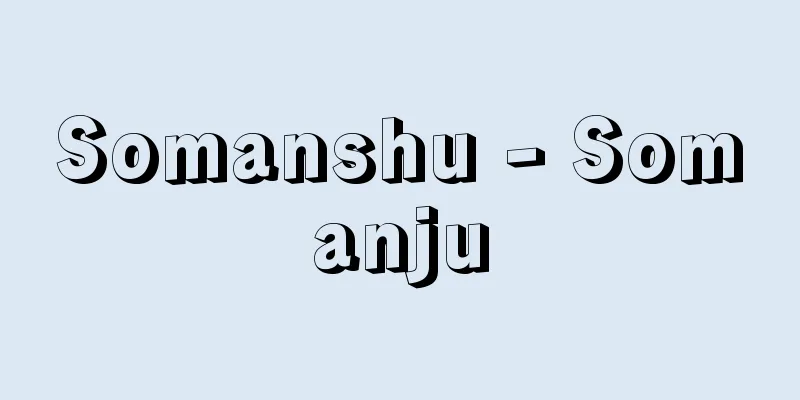Chikubu Island

|
[1] An island in the northern part of Lake Biwa, Biwa Town, Higashiasai District, Shiga Prefecture. It is home to Hogon- ji Temple, known as Chikubushima Kannon, and its Bentendo Hall enshrines one of the three great Benzaiten in Japan. It is also home to Tsukubusuma Shrine, known as Chikubushima Myojin . The island's silhouette, surrounded by deep greenery and reflected on the lake's surface, is one of the Eight Views of Lake Biwa. Its area is 0.14 square kilometers. It is a national historic site and a place of scenic beauty. *Shuui (around 1005-07), Autumn, 203, inscription: "When I visited Chikubushima, I was reflected in the water in the shadow of the maple leaves." [2] Heike. Fushimono. When Taira no Tsunemasa plays the biwa on Chikubushima, the myojin responds and appears as a white dragon. [3] Noh play. Waki-noh. Various schools. Author unknown. A nobleman meets an old fisherman and a young woman on a fishing boat on the shores of Lake Biwa, and is given a ride to Chikubushima Island. The two discuss how Benzaiten has a female body, so the island is not off-limits to women, and the woman disappears into the shrine, while the fisherman disappears into the sea. Soon Benzaiten and the dragon god appear, and perform the dance of the heavenly maiden and the Maibataraki , respectively. [4] Nagauta. Honchoshi. Composed by Kineya Rokuzaemon 11th. Original title: "Imayo Chikubushima." First performed at the Edo Nakamuraza Theater in 1862. The lyrics are taken from a Noh play, and describe the virtues of Myojin. They were used in the Honnoji scene in "Badarai no Mitsuhide ." Other works include Itchu-bushi and Tokiwazu-bushi. [5] Koto music. The Yamada school has two pieces: a calligraphy arrangement of Itchu-bushi, and a song based on a Noh play. The Ikuta school's songs are arrangements of jiuta (composed by Kikuoka Kengyo) that tell the story of the island's origins. Source: The Selected Edition of the Japanese Language Dictionary About the Selected Edition of the Japanese Language Dictionary Information |
|
[一] 滋賀県東浅井郡びわ町、琵琶湖の北部にある島。竹生島観音として知られる宝厳寺(ほうごんじ)があり、その弁天堂には日本三弁才天の一つがまつられる。また、竹生島明神として知られる都久夫須麻(つくぶすま)神社がある。深い緑につつまれて湖面にうつる島影は琵琶湖八景の一つ。面積〇・一四平方キロメートル。国史跡・名勝。※拾遺(1005‐07頃か)秋・二〇三・詞書「ちくふしまにまうで侍ける時、もみぢのかげの水にうつりて侍ければ」[二] 平曲。フシ物。平経正が竹生島で琵琶を奏すると、明神がそれに感応して、白龍となって姿を現わす。[三] 謡曲。脇能物。各流。作者不詳。朝臣が琵琶湖畔で釣り船に乗ってきた老漁夫と若い女に会い、乗せてもらって竹生島に行く。二人は弁才天は女体だからこの島は女人禁制ではないことなどを語り、女は社殿に、漁夫は海中に消える。やがて弁才天・龍神が現われて、それぞれ天女の舞と舞働(まいばたらき)を舞う。[四] 長唄。本調子。一一世杵屋六左衛門作曲。本名題「今様竹生島」。文久二年(一八六二)江戸中村座初演。歌詞は謡曲からとったもので、明神の神徳を述べる。「馬盥(ばだらい)の光秀」の本能寺の場で用いられた。ほかに一中節、常磐津節がある。[五] 箏曲。山田流は一中節を編曲した掛合いと謡曲による唄い物の二曲がある。生田流の曲は地歌(菊岡検校作曲)の編曲で島の由来を語るもの。
出典 精選版 日本国語大辞典精選版 日本国語大辞典について 情報 |
<<: Pilgrimage to Chikubu Island - Chikubu Island Pilgrimage
Recommend
Chuikov, VI (English spelling)
…The besieged Leningrad endured the winter, suffe...
General angle - Ippankaku
When two lines form an angle, the amount by which ...
oz ap (English spelling) ozap
...symbol dwt). (3) The apothecaries' ounce i...
Steamed Kuya - Kuyamushi
A type of tofu dish. Also called Kuya tofu. Cut t...
Kalanchoe - Kalanchoe
A perennial succulent plant of the Crassulaceae f...
General of the Guard
…Therefore, once a general was on the battlefield...
Nagasaki clan
A powerful vassal family of the direct line of the...
Betula maximowicziana (English spelling)
… [Yukio Taniguchi]. … *Some of the terminology t...
Cavalleria rusticana (English spelling)
…In 1984, he left school and became the conductor...
Nun - Ama
〘Noun〙① (Perhaps from the Pali word ammā meaning &...
ground effect machine
...They are also called ACVs (short for air cushi...
Indirect facts - Indirect facts
Facts that allow one to empirically infer the exis...
Williams, F.
...The representatives of the former are Drysdale...
Ballet man
…Examples: Act 2 of Giselle, Les Sylphides. Balle...
"Tolerance" - Kanyoron
…His efforts were rewarded, and on June 4, 1764, ...

![Anambra [State] - Anambra](/upload/images/67cf331a91cd5.webp)







